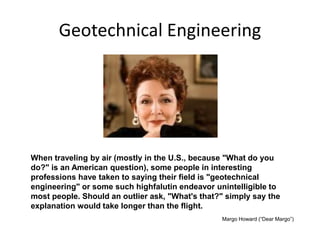All about Geotheta
All about Geotheta
Blog Article
The Single Strategy To Use For Geotheta
Table of ContentsMore About GeothetaGeotheta - QuestionsOur Geotheta PDFs5 Easy Facts About Geotheta DescribedGeotheta Things To Know Before You Get This

They conduct site examinations, accumulate samples, carry out research laboratory examinations, and evaluate information to assess the suitability of the ground for construction projects - Consulting Engineers. Based upon their findings, geotechnical engineers give recommendations for foundation layout, incline security, maintaining frameworks, and reduction of geotechnical threats. They work together with various other specialists, such as engineers, architectural designers, and construction groups, to ensure that geotechnical considerations are incorporated into the total project style and execution
By analyzing the actions and residential or commercial properties of soil and rock, they can determine possible geotechnical threats such as landslides, dirt negotiation, or incline instability. Their expertise aids prevent failings or crashes that can jeopardize lives and residential property. Below are some in-depth responsibilities and responsibilities of a geotechnical engineer: Site Examination: Geotechnical designers conduct website examinations to gather data on subsurface conditions.
They translate the information to understand the buildings and actions of the dirt and rock, including their toughness, permeability, compaction qualities, and groundwater conditions. Geotechnical Analysis and Design: Geotechnical engineers analyze the data accumulated throughout website examinations to assess the stability and suitability of the website for building tasks. They do geotechnical computations and modeling to examine variables such as bearing capacity, negotiation, slope security, side earth pressures, and groundwater circulation.
The 10-Minute Rule for Geotheta
Structure Style: Geotechnical engineers play a vital role in designing structures that can safely sustain the desired framework. They examine the dirt conditions and lots demands to determine the appropriate structure type, such as shallow foundations (e.g., grounds), deep structures (e.g (https://www.pageorama.com/?p=geotheta)., piles), or specialized techniques like dirt improvement. They consider factors such as negotiation restrictions, birthing capability, and soil-structure interaction to develop ideal structure layouts
They examine building and construction plans, display website tasks, and perform field inspections to verify that the layout referrals are complied with. If unanticipated geotechnical problems arise, they analyze the scenario and supply suggestions for remediation or adjustments to the layout. Threat Evaluation and Mitigation: Geotechnical designers analyze geotechnical risks and dangers connected with the task site, such as landslides, liquefaction, or dirt disintegration.

Partnership and Interaction: Geotechnical engineers function carefully with various other experts associated with a task, such as designers, architectural engineers, and building groups. Efficient communication and cooperation are important to integrate geotechnical factors to consider right into the general task layout and construction procedure. Geotechnical engineers give technical know-how, answer inquiries, and ensure that geotechnical needs are met.
The smart Trick of Geotheta That Nobody is Talking About
Here are some types of geotechnical engineers: Structure Designer: Structure designers focus on making and evaluating structures for structures. They analyze the dirt problems, load demands, and site features to identify the most suitable foundation kind and style, such as superficial structures, deep structures, or specialized strategies like pile structures.
They review the factors influencing incline security, such as dirt buildings, groundwater problems, and incline geometry, and establish methods to stop slope failings and reduce risks. Earthquake Designer: Quake engineers specialize in evaluating and designing frameworks to hold up against seismic forces. They assess the seismic risk of a website, examine dirt liquefaction potential, and create seismic layout standards to make sure the safety and security and durability of frameworks during quakes.
They do area screening, gather samples, and analyze the collected data to identify the dirt homes, geologic formations, and groundwater problems at a site. Geotechnical Instrumentation Engineer: Geotechnical instrumentation engineers focus on monitoring and determining the behavior of soil, rock, and frameworks. They install and keep instrumentation systems that keep an eye on aspects such as dirt negotiation, groundwater degrees, slope movements, and architectural displacements to examine performance and provide very early warnings of potential problems.
The Best Strategy To Use For Geotheta
They carry out tests such as triaxial examinations, consolidation tests, straight shear tests, and permeability examinations to gather information for geotechnical evaluation and layout. Geosynthetics Engineer: Geosynthetics engineers concentrate on the layout and application of geosynthetic products, such as geotextiles, geogrids, and geomembranes. They use these products to enhance dirt security, enhance slopes, provide water drainage options, and control disintegration.
They often tend to be investigative people, which means they're intellectual, reflective, and analytical. They are curious, systematic, rational, logical, and rational. Some of them are likewise social, meaning they're kind, generous, cooperative, client, caring, helpful, compassionate, sensible, and friendly - Geo Tech Engineer.
In the workplace atmosphere, geotechnical designers utilize specialized software program devices to carry out estimations, develop styles, and evaluate information. They prepare records, review task requirements, connect with clients and staff member, and coordinate job activities. The workplace setup offers a helpful atmosphere for research, evaluation, and partnership with other professionals associated with the job.
The Main Principles Of Geotheta
They often check out project websites to conduct website investigations, analyze geotechnical problems, and gather information for evaluation. These visits include taking a trip to different places, occasionally in remote or difficult surfaces. Geotechnical designers may carry out dirt tasting, conduct tests, and screen construction tasks to ensure that the geotechnical elements of the task are being executed appropriately.
Geotechnical engineers likewise work in specialized geotechnical labs. Geotechnical research laboratory engineers work extensively in these special info atmospheres, taking care of screening tools, running tools, and videotaping information.
Report this page